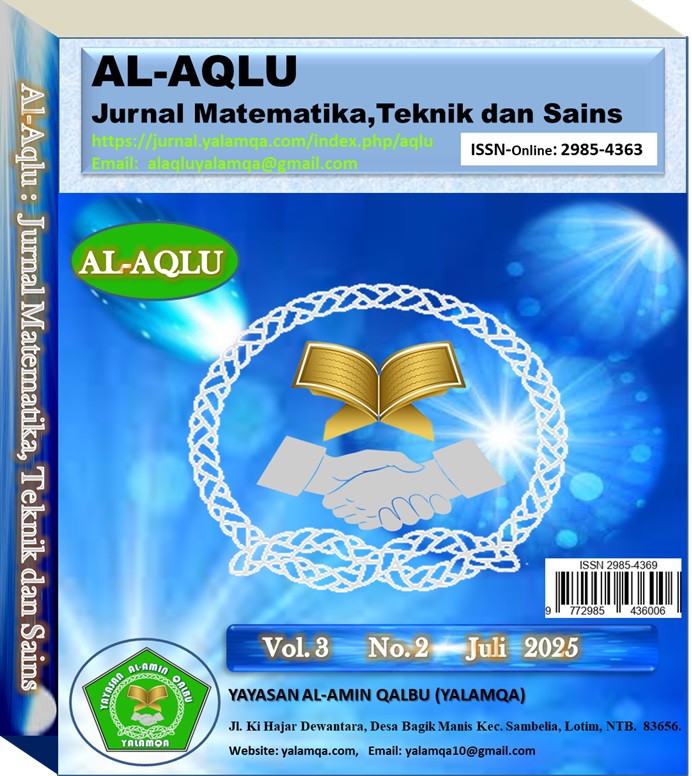PERBANDINGAN KINERJA METODE K-NEAREST NEIGHBOR (KNN), RANDOM FOREST, DAN DECISION TREE DALAM MEMPREDIKSI DIABETES
Comparing the Accuracy of K-Nearest Neighbour (KNN), Random Forest, and Decision Tree Methods in Predicting Diabetes
DOI:
https://doi.org/10.59896/aqlu.v3i2.299Keywords:
Diabetes, K-Nearest Neighbor, Random Forest, Decision TreeAbstract
Diabetes is a disease with a growing number of sufferers and is the cause of death of 1.5 million people in the world in 2019. A treatment for diabetes is needed, one of which is by predicting diabetics. The K-Nearest Neighbour (KNN), Random Forest, and Decision Tree methods are some methods that can be used to predict diabetes classification. This research aims to compare the performance of KNN, Random Forest, and Decision Tree methods based on accuracy and computation time. The data used in this study are Pregnancies, Glucose, Insulin, Body Mass Index (BMI), and Age as independent variables and Outcome as a dependent variable. The results of research on data that has not been normalised with Min-Max show that the KNN method has a faster computation time than the other two methods, while based on the accuracy value the Decision Tree method has a higher value than the other two methods. Furthermore, the Min-Max normalised data shows a decrease in the accuracy value of the Decision Tree and Random Forest methods, while the accuracy value of the KNN method has increased. Therefore, the Min-Max normalisation treatment is better used for the KNN method.
References
Alifah, R. N., Najib, M. K., Nurdiati, S., Sari, A. P., Herlambang, K., Ginting, D. T. P. B., & Sya’adah, S. N. (2024). Perbandingan Metode Tree Based Classification untuk Masalah Klasifikasi Data Body Mass Index. Indonesian Journal of Mathematics and Natural Sciences, 47(1), 49-65.
Andiriani, C. M. F., Susilaningrum, D. (2023). Klasifikasi Waiting Time for Pilot di Pelabuhan Tanjung Perak Menggunakan Metode Regresi Logistik - Synthetic Minority Oversampling Technique (SMOTE), Jurnal Sains dan Seni ITS. 12(1), 111-118.
Aprilliandhika, W., Abdulloh, F. F. (2024). Comparison Of K-Nearest Neighbor and Support Vector Machine Algorithm Optimization With Grid Search CV On Stroke Prediction, Jurnal Teknik Informatika, 5(4), 991-1000.
Aziz, M. I., Fanani, A. Z., Affandy. (2023). Analisis Metode Ensemble Pada Klasifikasi Penyakit Jantung Berbasis Decision Tree, Jurnal Media Informatika Budidarma, 7(1), 1-12.
Chairunisa, R., Adiwijaya, Astuti, W. (2020). Perbandingan CART dan Random Forest untuk Deteksi Kanker berbasis Klasifikasi Data Microarray. Jurnal Rekayasa Sistem dan Teknologi Informasi. 4(5), 805-812.
Gharehbaghi, A. (2023). Deep Learning in Time Series Analysis, Ed ke-1. Boca Raton (USA): CRC Press.
Handayani, P., Fauzan, A. C., Harliana. (2024). Machine Learning Klasifikasi Status Gizi Balita Menggunakan Algoritma Random Forest, KLIK: Kajian Ilmiah Informatika dan Komputer, 4(6), 3064-3072.
Hawari, I.F., Najib, M.K., Nurdiati, S., Marpaung, Y.F.Y., Kusumawati, N., Nurfadila, M., Sijabat, K.R. and Hernawan, B.F., (2024). Pengaruh Teknik Oversampling Pada Algoritma Machine Learning Dalam Klasifikasi Body Mass Index (BMI). Jurnal Riset dan Aplikasi Matematika (JRAM), 8(1), pp.51-68.
Kozak J. (2019). Decision Tree and Ensemble Learning Based on Ant Colony Optimization, Cham(CH): Springer Nature Switzerland AG.
Maskuri, M. N., Harliana, Sukerti, K., Bhakti, R. M. H. (2022). Penerapan Algoritma K-Nearest Neighbor (KNN) untuk Memprediksi Penyakit Stroke, Jurnal Ilmiah Intech: Information Technology Journal of UMUS, 4(1), 130-140.
Pratama, Y., Prayitno, A., Nazrian, D., Rizki, Y., Rasywir, E. (2022). Klasifikasi Penyakit Gagal Jantung Menggunakan Algoritma K-Nearest Neighbor, Bulletin of Computer Science Research. 3(1), 52-56.
Rahman, I. F., Shestia, W. A., Rama, S. D., Azzahra, S., Dermawan, A. A. (2024). Klasifikasi Diagnosa Pasien Di Klinik Sri Dengan Metode Decision Tree, Jurnal Teknik Ibnu Sina, 9(1), 74-82.
Setianto, Y. A., Kusrini, K., Henderi, H. (2018). Penerapan Algoritma K-Nearest Neighbour Dalam Menentukan Pembinaan Koperasi Kabupatem Kotawaringin Timur, Citec Journal, 5(3), 232-241.
Solahuddin. M., Purnamasari, A. I., Dikananda, A. R. (2023). Klasifikasi Kualitas Berita Pada Majalah Menggunakan Metode Decision Tree, Jurnal Teknologi Ilmu Komputer. 1(2), 48-54.
Telaumbanua, F. D., Hulu, P., Nadeak, T. Z., Lumbantong, R. R., Dharma, A. (2019). Penggunaan Machine Learning Di Bidang Kesehatan, Jurnal Penelitian Teknik Informatika, 2(2), 391-399.
Wardhana, R. G., Wang, G., Sibuea, F. (2023). Penerapan Machine Learning Dalam Prediksi Tingkat Kasus Penyakit Di Indonesia, Journal of Information System Management, 5(1), 40-45.
[WHO] World Health Organization. (2023). Diabetes. Tersedia pada: https://www.who.int/news- room/fact-sheets/detail/diabetes
Downloads
Published
How to Cite
Issue
Section
License
Copyright (c) 2025 Sherly Yulianty, Mohamad Khoirun Najib

This work is licensed under a Creative Commons Attribution-ShareAlike 4.0 International License.


















